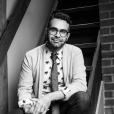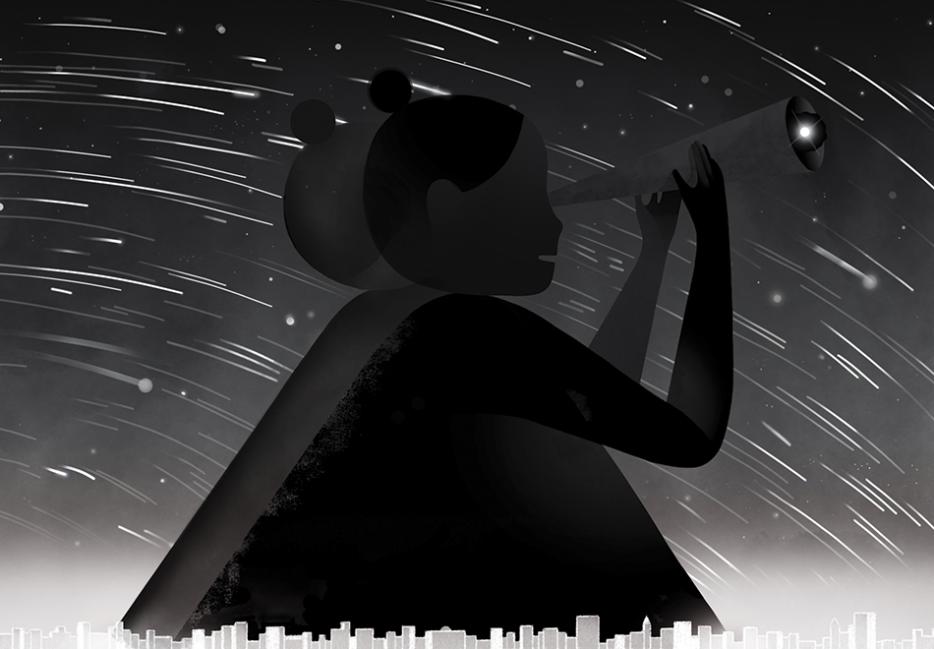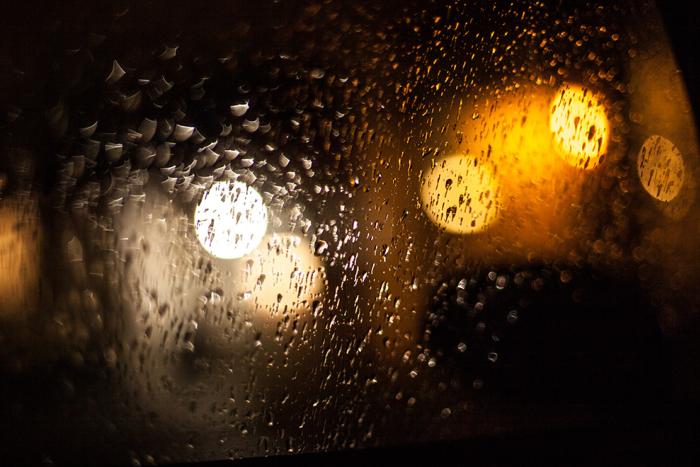Last month I found myself on top of a dark mountain attending a “star party.”
As much as it sounds like a Beverly Hills soirée or a drug-addled orgy, it is not. This star party is a gathering of a few hundred people at the McDonald Observatory in West Texas to look at the sky. Enormous telescopes were at my disposal and interpretive astronomers carried high-tech laser pointers that seemingly touched the stars. But, otherwise, it felt like an ancient ritual.
Peering through a lens at M38—a star cluster too faint for naked eyes that sparkles like diamonds through telescopes—I overheard a girl behind me ask, “What is that?”
“The Milky Way,” her mom replied. The girl let out the most awestruck gasp. “See, honey, this is why we get you out of Houston.”
City kid. Of course.
Unlike her, I grew up surrounded by countryside, where shortly after sundown anyone could count at least three stars in the sky. By the time mom tucked me in with stories from the hadith and flicked the lights, the big dipper glared at me from outside my window.
I had a generous view of the universe until leaving for college, which I’d forgotten until October 2014, when I returned for a friend’s wedding. It was a country party. There was a hog roast. And later, stumbling to town drunk, I found myself in the middle of a field staring at a glistening sky. Had I still believed in Him, I’d say it looked like God had sneezed glitter.
The next night I drove home to Edmonton with the Aurora Borealis by my side. It’d been there all my childhood but this was the first time I remembered noticing.
*
Two weeks after the wedding, I was on the road again, to the Rockies for Jasper Dark Sky Festival. This is the ultimate star party, with many times more people than were gathered in Texas. The festival started in 2011, shortly after the 11,300-kilometres-squared park was designated the world’s largest dark-sky preserve by the Royal Astronomical Society of Canada. (Wood Buffalo National Park in Northern Alberta, which is four times larger, took the record in 2013.)
The RASC's designations are based on the work of International Dark-Sky Association, or IDA, which has lobbied dozens of municipalities to adopt dimmer and glare-resistant street lighting, or get rid of it completely, and ultimately improve our views of the night sky. The IDA is headquartered in Tucson, Arizona, but the movement owes much of its success to the RASC for establishing influential light abatement guidelines, and the world’s first preserve in Southern Ontario in 1999. Parks Canada is a partner in the cause, making picturesque Jasper ideal to host such a festival. Outside the park’s few towns and lone highway, you basically need a flashlight to navigate the night, or, if you’re a hardcore star-watcher, a headlamp with a red bulb that protects your nocturnal visions and only gives as much spotlight as you need to not walk right into a grizzly den.
There are figurative stars at Jasper Dark Sky too, like Col. Chris Hadfield. I was eager to meet Canada’s sweetheart, but as I arrived at the media launch my mind was elsewhere: on my phone, and how dead it was, and how my charger was out of reach, and whether I could possibly go three hours without it. In other words, I am exactly the kind of phone-addicted, dead-eyed digital native the festival hopes to net with its slogan “Power Down, Look Up.”
A mass relighting of the Western world is well underway.
I pumped the home-screen button a few times but it wouldn’t resuscitate, so like a piece of my soul, I left it behind and entered a lodge occupied by marketers, journalists, bloggers and the guests of honour, members of the RASC. There was a crackling fireplace and warm buffet, but soon I was ushered out the back door and into the cold. The blinds were shut behind me. A group huddled outside around Alister Ling, a meteorologist and club member from Edmonton, who had one of those almighty laser pointers. But all it could touch were clouds. The sole reason we had come was out of reach.
Time to power up. A fellow member gave Ling an iPad. He held it over his head and, aided by a constellations app, GPS and brute digital force, he stole back the hidden stars. They glowed red; he tapped a feature that connected the red dots and defined them as ancient Greeks did: Gods with simple stories and simpler bodies. It was very unimpressive. Eventually he turned it off and told his own stories in a quiet campfire voice.
Ling reminisced on the last full lunar eclipse, for which he braved frigid weather in a parka, two sleeping bags and two toques, all to bear witness on a disappearing moon and the purest skylight he’d ever known. “Suddenly I heard a thumping sound,” he said. Ling mimicked the noise with his teeth and cheeks. “Then I realized that it was blood rushing through my head.”
That he experienced this alone was a point of equal beauty and sadness. Later, he would share with me a statistic oft repeated by dark-sky advocates, that two-thirds of the U.S. population can’t see the Milky Way anymore. “Artificial light robbed us of our heritage of seeing the sky. It’s even worse now.” He imitated texting. “A lot of people don’t look up.”
Even if we could fix the obstruction of artificial light overnight, Ling doubted most people, especially younger ones, would have the patience to make star-gazing a hobby. We crave instant gratification, so we’re far more likely to stare at the light in our hands than the light in the sky.
*
It’s absurd to think humans should need a protected area or festival to remind them to gaze upward, something that once came to us as naturally as breathing. Given something to see, though, the hardwired urges kick in. During the 1994 Los Angeles earthquakes and subsequent blackout, a nearby observatory was flooded with calls from Angelenos reporting an ominous bright streak looming above. They wondered if the celestial shape was responsible for whatever shook them awake. It was the Milky Way, of course, but it goes to show how primed we are to seek answers in space.
Plains Cree people formed a genesis story around a rupture in the sky, not unlike a wormhole, from which they arrived as spirits before transforming into mortal humans. According to aboriginal educator Wilfred Buck, Cree—“the star people,” as Buck calls them—have several names for the Milky Way: meskinow (path), sipi (river) and apchak sipi (spirit river). Like all ancient cultures, his ancestors designated the constellations names and mythologies in order to package the cosmos into a tidy tale. They were among the first amateur astronomers, a field that, today, is one of the few areas of interest wherein “amateur” isn’t a pejorative but a badge of honour.
He warns against Big Light’s less-than-honest salesmen and compares their denial of adverse health effects to the tobacco industry.
Amateurs are responsible for important discoveries about the Milky Way from the last half-century, plus some Hubble Telescope equipment that has let us see far beyond it. We have to thank for this movement the so-called International Geophysical Year of 1956 and a Smithsonian initiative called Operation Moonwatch that, for two decades, mobilized everyday men, women and children to help plot the first artificial satellites. What this did for the hobby is encapsulated by this 1958 Popular Science headline: “Suddenly, Everybody Wants a Telescope”.
The RASC naturally benefited and saw subsequent membership surges following Apollo 11 and Halley’s Comet in 1986. Then with the amateur-assisted discovery of the Hale-Bopp comet, in 1995, the 4,000-person group soared to 5,000.
That was also the year my parents bought into a growing phenomenon called the Internet, which helped make Hale-Bopp history’s most widely observed comet. Observatory’s web sites tracked it and published daily images; fan sites counted down to its perihelion. In San Diego Heaven’s Gate thought its approach to the sun meant it was primetime for a suicide pact, but in High Prairie, Alberta, 10-year-old me only thought to spend his savings on a cherry red telescope from the Sears catalogue.
On April 1, 1997, Hale-Bopp slowly scraped the sky with a green tail bright enough for any land mammal to see. But my only memory of my brief brush with amateur astronomy is feeling ripped off by that cheap telescope. Maybe it was just snowing that night, can’t remember, but I definitely never touched it again.
I wasn’t alone. The RASC’s executive director told me membership tanked after Hale-Bopp. But it has bounced back with a renewed interest in astrophotography, thanks to cameras and telescopes being better and cheaper than ever. On their first night out, amateurs capture images orders of magnitude better than professionals did in the 1970s. At the Edmonton chapter, Ling has also witnessed a membership surge, and gender within the historically male-dominated hobby is balancing out. But he said members are of a certain age. “One thing that’s really obvious is it’s lacking youth.” In 1967, 14-year-old Ling’s dad lied to the RASC in order for his underage son to qualify for a membership; now it’s rare to meet members under 40. “Nerds these days are into gaming.”
*
If amateur astronomy was struggling to be relevant to young people, it didn’t show at the family-friendly Dark Sky Festival. The second night was blessed with clear skies and the disappointment of yesterday turned into hour-long lineups at the entrance gate. I roamed around with a red headlamp and my neck craned to the cosmos, knocking into people equally captivated by the perfectly starry night. We whispered our sorries and bounced between information booths and telescopes manned by interpreters who talked not just of the value of darkness to astronomy but to life itself.
A Parks Canada interpreter and amateur astronomer who’s exuberance was fit for children’s television struggled to control his volume as he explained to me how artificial light confuses animal’s circadian rhythms and effectively leaves nocturnal creatures jet-lagged. That would be a problem for, say, beavers, which are slow, clumsy and basically defenceless, hence why they work under the cover of darkness despite having crappy eyesight.
I noted the term scotobiology—the study of the effects of darkness on biological systems—and wished to learn more about it. I requested a phone call with the interpreter through Parks Canada’s communications bureau. It took over four weeks to get approved. Public relations was weirdly nervous and repeatedly asked for my questions in advance. By the time we finally connected, the interpreter’s exuberance was overtaken by reticence and scripted explanations to questions I hadn’t asked. Apparently embarrassed, he admitted that he was literally reading media lines provided to him. (So much for new Prime Minister Justin Trudeau’s unmuzzling.)
I thanked him for trying and suggested he just email me the interview since Parks Canada had already conducted it for the both of us. We proceeded to have a friendly chat about his hobby and Cree cosmology, but when I asked again about scotobiology he clamped up. “Scientists believe there is some impact from light on nocturnal animals. Parks Canada is not doing any scientific monitoring on this, at the time.” He paused. “That is the media line I was given.”
In fairness to the interpreter, scotobiology is a very new science. But it’s an accepted fact that the last century’s combined urban sprawl and electrification is screwing with ecosystems. The research is apparently off-base for Parks Canada, but amateurs and professionals waste no time telling me about whole flocks of birds that’ve smashed into floodlit smokestacks, and sea turtle hatchlings that are primed to follow moonlight from sand to sea but instead walk inland toward their deaths. “Every nocturnal creature in the world is attuned to light no stronger than the full moon,” said Ling. But it might not be limited to nocturnal creatures. “Light increases hormones in chickens and makes them produce more eggs, so is that why girls reach puberty faster?” he wondered. “It may not be all the hormones in the beef.” Ling’s tendency to blame artificial light for human predispositions isn’t exactly junk science. Diabetes, obesity and certain cancers—preliminary study after preliminary study correlates them with excess light. And, yes, one accepted theory for why girls are developing breasts and pubic hair earlier is excessive exposure to light. (Another is absentee fathers, so make what you will of this.)
The dark science has roots in Canada. At a 2003 symposium called Ecology of the Night, “scotobiology” (from the Greek skotos, meaning darkness) was added to the scientific lexicon. University of Ottawa instructor Robert Dick, who in fact coined the term with biologist Tony Bidwell, remembers attending as an astronomer amongst psychologists, entomologists and ornithologists. “I went there to talk about the impact on the night sky and they were talking about the impact on biological systems. I was astounded. After a few years of study, I realized darkness had nothing to do with astronomy and everything to do with biology.”
A common ground was established. Astronomers would now leverage scientific research to clear the skies and scientists could leverage astronomers’ well-established light pollution abatement committees for their causes. After all, health concerns are far more alarming to governments than the argument that, as Ling put it, you’re robbing us of our heritage. But what’s most convincing is cost-savings. So across North America, in cities as large as Calgary and Toronto, new bylaws and policies are effectively replacing energy-wasting, halo-casting, upward-facing streetlamps, with clearer, softer, downward-facing LED bulbs. A mass relighting of the Western world is well underway.
Dick consulted Ottawa on its 1990s lighting policy before founding his own dark-sky friendly company for amber lights that don’t spoil nighttime vision. He doesn’t just sleep with very thick blinds; he takes a self-made amber flashlight to the washroom at night to avoid the shock of white light. To say he’s concerned about the effects of artificial light is an understatement. He warns against Big Light’s less-than-honest salesmen and compares their denial of adverse health effects to the tobacco industry.
He’s particularly worried about blue light, the wavelength ironically emitting from the same anti-light pollution LED bulbs that cities are adopting en masse, as well as whatever you’re using to read this. During the day blue light boosts moods and reaction times, but too much of it after sundown can reduce your melatonin, a hormone that sets your internal clock and may be responsible for the aforementioned health problems. As if it wasn’t enough that staring into my smartphone for hours every night was distracting me from the night sky, it was now trying to kill me. I suppose I could invest in orange-tinted, Bono-esque glasses that block blue light, like Alister Ling recommended. He also bought a pair for his teenage daughter but she refuses to wear them. “She’s too headstrong to take my advice,” he told me. “I don’t get it.”
*
It’s easy to want to call anti-light pollution activists “luddites” and remind them of the incredible access we now have to outer space via our digital one. After all, it was the instantly gratifying Internet that formed my own interest in cosmology and humanism.
As dust collected on my cheap, cherry telescope, I spent countless hours exploring the web, which was starting to feel as infinite and ever-expanding as the universe itself. That’s where I latently discovered Carl Sagan, which led to astronomers Phil Plait and Neil deGrasse Tyson, a pompous detour into Richard Dawkins territory, before I fell in love with Chris Hadfield’s Twitter, like just about everyone else.
But for amateur astronomers and dark-sky advocates, who heavily rely on the web for recruitment and public outreach, this is a supplement, not a substitute, for the real thing—a glittering sky versus a glowing red iPad screen. Virtual Hubble images and viral space videos lunge at me like comets, but all the while my real view of the universe disappears and with it…what exactly? Standing under Jasper’s skies—or on the Davis Strait Mountains or in a field outside my hometown—I was overtaken with a daunting and yet calming sensation that I couldn’t quite pinpoint. Ling said it was a sense of my own insignificance but, whatever it was, its absence feels quite significant.
On the last night of the Dark Sky Festival, the press got thirty minutes with Chris Hadfield before his keynote address. I asked him, given that more people now lived in cities than not, was he concerned that humans were losing touch with the sky?
The Colonel smiled with a smugness that only someone who’s space-walked could possess. “Not much,” he said, “because I’ve seen the whole world. Everyone who writes about overcrowding lives in a city. It’s quite comical. But most of the world is empty. And most of it is dark at night.”
Editor's note: Originally, this piece incorrectly stated that the IDA designated the Canadian Dark Sky Preserves, and that Allister Ling joined the group in 1967. Hazlitt apologizes sincerely for the errors.






